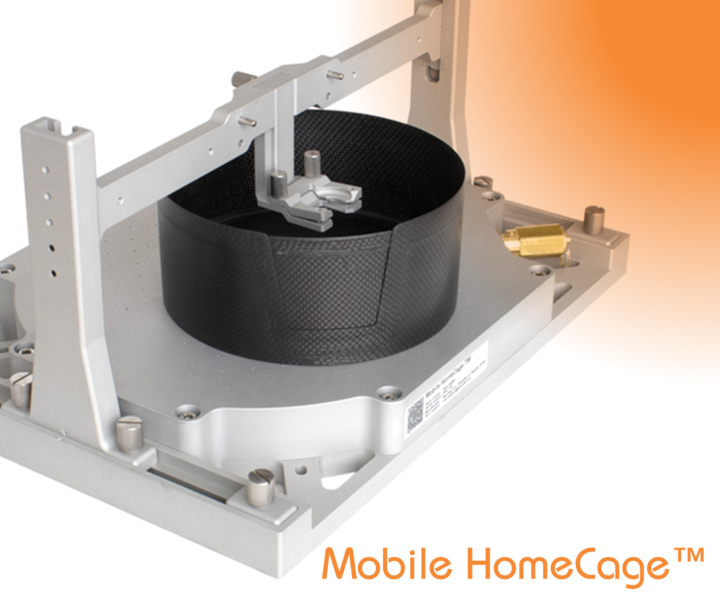Mobile HomeCage
Neurotar

Device to immobilize the head of an awake rodent.
Optical and electrical recordings performed in live rodents have revolutionized brain research. However, the use of
anaesthetics affects brain function and diminishes the relevance of in vivo experiments. This limits the number and
frequency of recording sessions. Neurotar's Mobile HomeCage solves these problems. It easily fits under most existing upright
microscopes and provides a real, tangible environment for an animal to explore and navigate. It provides a stable, firm head
fix during recording or imaging experiments on awake, behaving rodents.
Key Benefits
- No need for anaesthetics during experiments and animal training
- Robust head fixation of a freely moving awake animal for optical or electrical access to the brain cells
- Only 4 days of training necessary (contact us for the training protocol)
- Enables researchers to combine behavioral tests with two-photon microscopy, electrophysiological recordings, optogenetics, intrinsic optical imaging an more
- Provides a real environment with tangible walls and flat floor to creatures that love to sniff and touch
- Test animals can be monitored as they socialize, sleep or respond to sensory stimuli
- Up to 4 experimental sessions per day possible (cp. 1-2 day intervals in anaesthetized animals)
- Compatible with the microscope frames from all major manufacturers
View the open-access peer-reviewed 2014 JoVE publication on Mobile HomeCage.
| Animals |
Intended for use with laboratory mice (up to 50 g); rat applicatons under development. |
| Head Fixation |
The procedure of head fixation does not require anesthetizing the mouse |
| Dimensions |
width x depth x height: 42 cm x 30 cm x 5 cm (with bridge - up to 21.3 cm) |
| Total Weight: |
8 kg |
| Input Pressure Range |
20-60 PSI (requires connection to an outlet of a standard laboratory pressurized air source). |
| HeadFix |
A simplified version of Mobile HomeCage designed for experiments on anesthetized animals. HeadFix can be upgraded to the full Mobile HomeCage device by adding AirLift upgrade kit. |
| AirLift |
An upgrade kit for HeadFix, which brings full functionality of Mobile HomeCage for work with awake animals. |
| Helicopter Metal Bar (HMB-4) |
Designed for rapid but extremely firm fixation of the animal's head to the Mobile HomeCage (awake animals) or to the HeadFix (anesthetized animals). The metal bar is attached to the animal's skull with dental cement (ask us for an advice on the cranial window implantation surgery). HMB-4 stands for four-millimeter inner diameter of the central opening (where cranial window is placed); larger sizes of HMB, as well as custom-shaped metal bars, are also available upon request. |
| Rabbit metal bar (RMB-4) |
A two-winged version of the helicopter metal bar (HMB), which provides a sufficient head fixation strength for experiments on anesthetized animals, but may not be strong enough for awake animal head immobilization. |
| Hippocampal window kit (HWK) |
This kit consists of a special glass insert (1.5 X 1.5 mm cylinder) and one of the metal bar versions (HMB or RMB, for awake and anesthetized animal imaging respectively). By implanting a hippocampal window using the HWK, superior quality imaging within hippocampus can be achieved. |
| Hex screw set (HSS) |
If you accidentally displace or damage some of the hex screws included with your Mobile HomeCage or HeadFix device, you can order a replacement screw set from us. |
| O-ring (ORN) |
The O-ring prevents air from leaking between the two halves of the air dispenser of your Mobile HomeCage or AirLift. If you accidentally damage the O-ring while disassembling or re-assembling the air dispenser, you can order a replacement O-ring from us. |
| Carbon cage (CCG-18) |
The robust but extremely light-weight (67 g) carbon cage is carefully designed to provide the air-dynamic properties required for smooth friction-free levitation of the cage during animal's navigation. CCG features a removable wall insert facilitating placement of the cage into Mobile HomeCage with a head-fixed animal in it. CCG-18 stands for eighteen-centimeter diameter of the carbon cage; larger sizes will be available soon, once we complete the ongoing development of MHC-XL (enlarged version of Mobile HomeCage designed for use with rats and for incorporation of customized maze walls). |
| Air dispenser filter (ADF) |
The ADF filter is placed inside the air dispenser of your Mobile HomeCage or AirLift to ensure an even and steady flow of air, which translates into a balanced levitation of the carbon cage during the animal's navigation. |
| Aluminum case with trolley (ACT) |
By default, your Mobile HomeCage or HeadFix will arrive in a cardboard box with a foam insert enclosing individual parts of the device. If all you need to do is unpack and install the device in your lab once, this packaging is perfectly suitable. However, if you expect to move the device between different locations, it may be a good idea to order a special aluminum case that features trolley wheels and convenient extendable handle (much like a luxury travel suitcase). |
|
|


